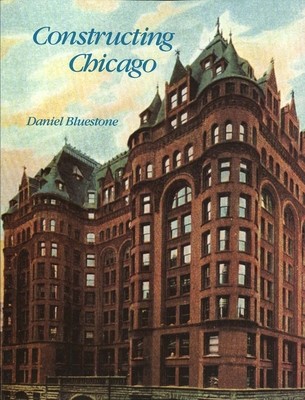
- Išsiųsime per 10–14 d.d.
- Autorius: Daniel Bluestone
- Leidėjas: Yale University Press
- ISBN-10: 0300057504
- ISBN-13: 9780300057508
- Formatas: 21.7 x 27.9 x 1.6 cm, minkšti viršeliai
- Kalba: Anglų
- Extra -15 % nuolaida šiai knygai su kodu: ENG15
Atsiliepimai
Aprašymas
Chicago's impressive industrial expansion in the late nineteenth century convinced most observers that the city was defined by the crass pursuit of wealth and that its architecture was, as described by Lewis Mumford, "a brutal network of industrial necessities." In a major new book, Daniel Bluestone disputes this vision of the city. Combining architectural history and cultural analysis, Bluestone explores the creation of Chicago's parks, churches, skyscrapers, and civic buildings. He finds that the structure of the city was influenced as much by the moral, cultural, and aesthetic aspirations of its local elite as by the untempered forces of commerce and capital. Bluestone shows how nineteenth-century Chicago architects and their clients attempted to create a distinctive landscape that could distract residents and visitors form the gritty commercial workings of the city while demonstrating a commitment to urbanism that went beyond the marketplace. He surveys the parks that were created to mediate relations between social classes; the churches relocated in residential areas so that they could avoid the dominance of new downtown buildings; the plans for lakefront civic centers architecturally distinguished from the forms of the city's famous early skyscrapers-including the Rookery, the Monadnock, the Columbus Memorial, and the Masonic Temple. And he examines these early Chicago skyscrapers, noting how their monumental entrances, embellished lobbies, artistic elevators, and spacious light courts were designed to soften their commercial edges to recast the city's image, and to cultivate an emerging middle class of white-collar workers. A richly illustrated contribution to urban and architectural history, Bluestone's book is also a perceptive look at central features in the design of this quintessential American city.
EXTRA 15 % nuolaida su kodu: ENG15
Akcija baigiasi už 1d.02:55:26
Nuolaidos kodas galioja perkant nuo 10 €. Nuolaidos nesumuojamos.

- Autorius: Daniel Bluestone
- Leidėjas: Yale University Press
- ISBN-10: 0300057504
- ISBN-13: 9780300057508
- Formatas: 21.7 x 27.9 x 1.6 cm, minkšti viršeliai
- Kalba: Anglų
Chicago's impressive industrial expansion in the late nineteenth century convinced most observers that the city was defined by the crass pursuit of wealth and that its architecture was, as described by Lewis Mumford, "a brutal network of industrial necessities." In a major new book, Daniel Bluestone disputes this vision of the city. Combining architectural history and cultural analysis, Bluestone explores the creation of Chicago's parks, churches, skyscrapers, and civic buildings. He finds that the structure of the city was influenced as much by the moral, cultural, and aesthetic aspirations of its local elite as by the untempered forces of commerce and capital. Bluestone shows how nineteenth-century Chicago architects and their clients attempted to create a distinctive landscape that could distract residents and visitors form the gritty commercial workings of the city while demonstrating a commitment to urbanism that went beyond the marketplace. He surveys the parks that were created to mediate relations between social classes; the churches relocated in residential areas so that they could avoid the dominance of new downtown buildings; the plans for lakefront civic centers architecturally distinguished from the forms of the city's famous early skyscrapers-including the Rookery, the Monadnock, the Columbus Memorial, and the Masonic Temple. And he examines these early Chicago skyscrapers, noting how their monumental entrances, embellished lobbies, artistic elevators, and spacious light courts were designed to soften their commercial edges to recast the city's image, and to cultivate an emerging middle class of white-collar workers. A richly illustrated contribution to urban and architectural history, Bluestone's book is also a perceptive look at central features in the design of this quintessential American city.




Atsiliepimai